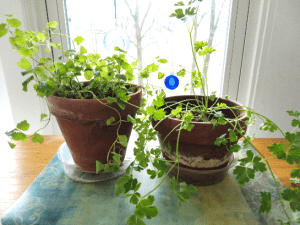Many of us are living on tight budgets and avoiding extra trips to the store, so it’s a good time to clean out the cupboards and use up some of the dried herbs lurking in the back corners. 
Whether you say Erbs (US) or Herbs (UK and Martha Stewart), using herbs can add flavor to meals and replace salt or other seasonings high in salt. A little chopped parsley or scallions on top of leftovers sparks them up with color, flavor, and texture. Once you’ve finished your hidden stash of herbs, what next? Those little glass jars at the grocery store are expensive. And the large containers at the dollar store may have been imported, shelved for months, or contain unwanted pesticides or fillers. Your best bet? Buy bunches of herbs or herb plants locally. Dry or freeze your extra bounty.
No garden space? Most herbs do fine in pots on the porch or a windowsill. Plastic milk jugs with holes in the bottom work great. Growing herbs in containers is a wonderful way for kids, older adults, and people with mobility conditions to keep their green thumbs active.
Parsley, sage, rosemary, and thyme (let’s sing it!), and lemon balm can be happy outside all summer then brought inside for the winter. But basil is fussy: it loves hot, humid weather but won’t tolerate colder fall temperatures. Bring it in well before first frost. If you’re lucky, a basil plant may hang on until December (and the flavor is worth the trouble), but it usually dies off when the air in the house gets too dry.
Oregano and mint, left in the ground outdoors, will come back in the spring and keep on giving. In fact mint will try to take over the world; plant it in a large container buried in the ground. Even so it often escapes and fills a corner of the yard. More on growing, using, and saving herbs in the links below.
Tabouli Bulgur Wheat Salad
A great summer recipe with minimal cooking! Bulghur is a healthy, hearty whole grain from the Middle East. If you have a choice, fine or extra-fine is preferred to coarse. Prep is easy: add boiling water and let sit for 30 minutes. You can substitute cooked brown rice instead. Don’t have all the veggies or herbs on hand? No worries…use what you have. An optional can of rinsed, drained chickpeas adds nuttiness and protein.
Ingredients:
1 cup dry bulgur wheat
1 cup hot water
1⁄2 cucumber, chopped
2 stalks celery, chopped
1 tomato, chopped
4 green onions, chopped
1⁄4 cup fresh chopped mint (or cilantro)
1 cup fresh chopped parsley
1 clove garlic, minced or 1/8 teaspoon garlic powder
Technique! Video on chopping Parsley and Herbs for this recipe
DRESSING
1⁄4 cup lemon juice (or vinegar or half of each)
2 Tablespoons vegetable or olive oil
1 teaspoon pepper
1⁄4 teaspoon salt
Directions:
- Place the bulgur in a large bowl and soak in the hot water until water is absorbed, (about 30 minutes). When it’s ready, drain any excess water.
- Mix the dressing ingredients together. Set aside.
- Chop the vegetables and add to the prepared bulgur.
- Add dressing to salad and stir. Refrigerate for 2-3 hours and serve chilled.
- Refrigerate leftovers within 2 hours.
Notes:
- Top with plain yogurt.
- Add other chopped veggies including red or green peppers, garbanzo beans (chickpeas), grated carrots, or summer squash.
- Freeze extra lemon juice to use later.
- Serve as a side dish or on lettuce leaves or in sandwiches with whole wheat or pita bread.
Nutrition Facts Recipe credit Photo credits: J. Martin; https://www.foodhero.org/
RESOURCES:
Add a Little Spice (& Herbs) to Your Life!: recipes for herb and spice blends; oodles of other good info.
Cornell Garden-Based Learning web site: growing annual and perennial herbs
Brought to you by:
Joan Martin
SNAP-Ed Nutritionist, Southern Finger Lakes Region
jdm458@cornell.edu



